Facts about Ocean Tides
We spend a lot of time studying the tides before we go metal detecting, so we thought we would add some information about the effects of ocean tides and the water, just in case other people are interested too. Most of this information comes from an old geology book we have, and is to be considered just basic, general information.Phases of the moon
The ebb and flow of the tides vary with the phases of the moon. Tides are not predicted from a general theory , but because tidal records have been kept for many years at that particular port.
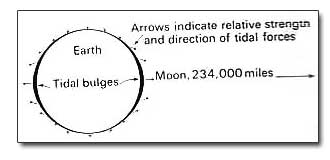 Twice during the lunar month, at the new and full moon, the sun and moon lie on a straight line passing through the earth and their influences are additive. These are the times of extreme tides (spring tides). At other times their tide producing forces tend in some degree to neutralize each other.
Twice during the lunar month, at the new and full moon, the sun and moon lie on a straight line passing through the earth and their influences are additive. These are the times of extreme tides (spring tides). At other times their tide producing forces tend in some degree to neutralize each other.
At the moon's first and third quarters their influences are directly opposite, and the tides are the smallest (neap tides).
In other words, the gravitational pull of the moon and/or sun creates a bulge on the earth's surface of water. But this massive lifting of water cannot be attributed to just the gravitational pull of the moon, for it is too small of a pull. A lot of this also has to do with the seasonal changes and the tidal currents too.
Beach Erosion
Most interest in tides is in their erosional power. Experiments show that water moving half a mile an hour will transport medium-size sand grains, and at three miles an hour will carry gravel an inch in diameter. So, they have evidence that the tidal current significantly affects the size, sorting, and distribution of sediment over most of the sea floor.
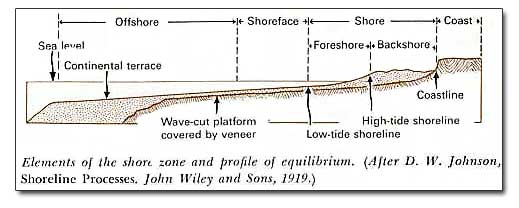 The mechanism by which the wind produces waves is complex.
The mechanism by which the wind produces waves is complex.
In theory, air friction should not be enough to cause waves until the wind speed is 11 to 15 miles per hour, yet winds of only 2 1/2 miles per hour do produce waves.
The best time to water hunt is when the wind is coming from the opposite direction of the shoreline. For instance, if you have a beach that faces south, a wind from say, the northwest, would flatten the waves, making it easy to hunt.
Longshore drift
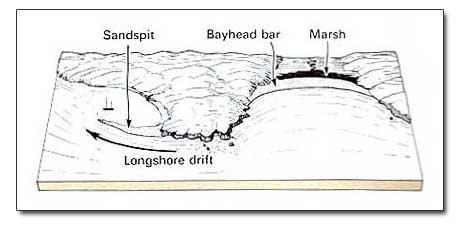 Next we have a picture of how longshore drift affects the shoreline. Most waves break against the shore at a slight angle, so that the swash of the breaking wave actually runs kind of parallel to the shore. When this happens it produces a current along the beach called a longshore drift which may consistently flow in one direction, or maybe the reverse depending on the wind.
Next we have a picture of how longshore drift affects the shoreline. Most waves break against the shore at a slight angle, so that the swash of the breaking wave actually runs kind of parallel to the shore. When this happens it produces a current along the beach called a longshore drift which may consistently flow in one direction, or maybe the reverse depending on the wind.
The breaking waves carry sand and gravel up the beach (the sand grains go farther than the gravel).
But the swash of the retreating wave also has a longshore component and so each particle moves in a sawtooth-like pattern down the beach. The scientists have marked pebbles made from bricks and have watched them move along a beach as much as half a mile in a single day.
Riptides
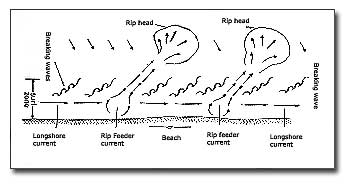 What is a riptide, and why are they so dangerous? Let's see if we can explain it in simple terms. If you look at the chart here, this is what happens. The ocean waves hit the shore at about a 30 to 60 degree angle. The longshore drift runs parallel to the shore picking up sand with it as it goes. The water running parallel to the shore eventually has to return to the ocean, which means it needs to break through the incoming waves at some point.
What is a riptide, and why are they so dangerous? Let's see if we can explain it in simple terms. If you look at the chart here, this is what happens. The ocean waves hit the shore at about a 30 to 60 degree angle. The longshore drift runs parallel to the shore picking up sand with it as it goes. The water running parallel to the shore eventually has to return to the ocean, which means it needs to break through the incoming waves at some point.
So what happens is, the sand on the sea bottom combines with a new wave pattern that allows the longshore to break through and return to the sea. This gap opens up, and the longshore drift must speed up which results in a very strong flow. This fast moving water will quickly take an unwary swimmer way out past the surf zone. So what do you do if you get caught by a rip current?
Recommendations are as follows, to swim parallel to shore till you are clear of the flow going out, and then swim in towards shore. It is impossible to fight the current, however, it may pull you out, but it will not pull you under.
Groins and jetties
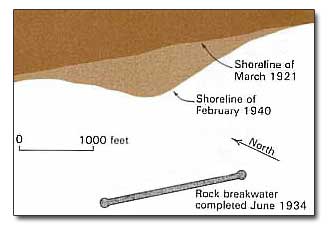 Notice what happens in this picture on the right when they make rock breakwaters.
Notice what happens in this picture on the right when they make rock breakwaters.
This is important information for water detecting or beach hunting because these rock breakwaters change the beach dramatically through the years.
Even more striking effects have followed the building of groins on many of the bathing beaches. Groins are low walls extending seaward from the high tide line. They are built to prevent sand removal by longshore drift.
Even though they have been successful in holding the fine sand on the bathing beaches, the beaches farther down are being deprived of their normal supply of traveling sand, and have been severely scoured and changed from sandy beaches to gravel or pebble ones.
Some tide prediction sites.
Maine
Harbors
Or get a Casio tide watch